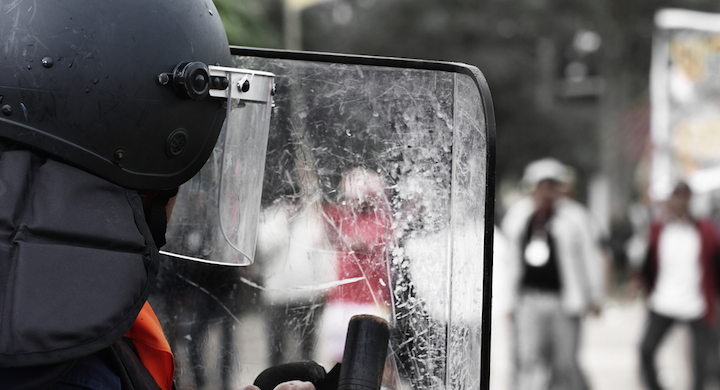After dismissal, high school students in Baltimore went to the new shopping center, built after The Wire made their community—Freddie Gray’s community—famous.
Freddie Gray is dead. No one is talking.
Trust is dead.
The police came with their face shields in place. The students and the police lined up, ready to do battle, like the two armies in the Hindu sacred book Bhagavad Gita. It seemed too late for talk. Too late to seek truth, then trust. All that was left were two fearful armies, fated to act out the script of distrust.
Watching this tragedy unfold on television, I saw a major fire on the screen, near the Baltimore Harbor. I thought of Francis Scott Key, watching fires in the same harbor, from the battle between the new U.S. Navy and what had been the omnipotent British fleet, prompting his famous words: O say can you see by the dawn’s early light…
Can we see by the dawn’s early light? Can we—the forces of love and justice—by the dawn’s early light, unify around a comprehensive strategy to get people talking, seeking the common truth of reality, and repairing the breach of trust. It’s too late to create trust when the police are wearing face shields.
Our response must be comprehensive. Not just an indictment of the system and the officers that killed Freddie Gray. We must also indict the economic and social systems that led to distrust. And we must repair the breach in our society with long term anti-poverty, economic and human development investments. We must agree on a transformative strategy, not just for Baltimore, but our nation, because what is happening in Baltimore is not an isolated problem. Baltimore—like Ferguson, Staten Island, Sanford, Charlotte, North Charleston, and others—is a metaphor. People in every city in North Carolina and in other states must understand this.
Our young people, black, white, and Latino, have nightmares of heavily armed white cops killing unarmed black and Latino men. Most of our kids have not been taught the historic role of well-armed white men, empowered by white slave holders, corporation owners, and urban landlords to protect their property—slaves, women, stores, and banks. Because we don’t understand how the racist system was built, we often don’t realize that the occasional overt display of rage is the result of daily ongoing traumatic syndrome or DOTS. This rage is produced by years of insults to our dignity. The exposure of the constant killing of black men—these killings have been routine since racialized slavery was invented—by officers of the law triggers the rage.
We believe fully in nonviolence and do not condone rioting or the destruction of property. But we must see the connections between the violence of rage and the totality of police violence—not to justify violence, but to clarify the dynamic of distrust. As Dr. King said, rioting is often “the language of the unheard”.
We now watch communities that have long been under siege with no strategy to build trust. Television and internet images keep the DOTS on the front burner, and the killing of one of your neighbors with no immediate response causes the pot to boil over. The hyper police violence that seems to be getting worse is connected to a white backlash that, U.S. historians remind us, always accompanies the fear of power shifts in America.
Leaders like W.E.B. Du Bois, Ida B. Wells, and George White understood this about lynching. We are living through a similar power shift today.
Many believe police brutality and violence against unarmed blacks is a perverted political act. Such acts have been condoned and rationalized by a dual system of justice. It is wrong to think of them as an isolated, individual act of violence. State terror is the proper term for acts that “put a community in its place”. We must therefore deal with the system’s sickness.
Such a comprehensive response includes trials of police who wrongfully kill and cover-up the killings. It includes transparency of information—immediate sharing of information with the family and neighbors of the victim of the white backlash. It includes training for officers, to unpack racist stereotypes, using young people from the streets as trainers in creating authentic community protecting and serving, as opposed to driving by and occupying. It includes tracking of police brutality with data reporting and community review boards that include legitimate representatives from the “hood” with real subpoena power. It includes taping interactions with body cameras, cell phone cameras, inside and outside vehicle cameras. It includes a transformation of the discriminatory practices in our “justice” system in arrests, investigations, indictments, trials, sentencing, and prisons.
Without these, we cannot achieve trust. We will not achieve trust.
All of the forces of love and justice have the ability to create a national response rooted in these ideals.

